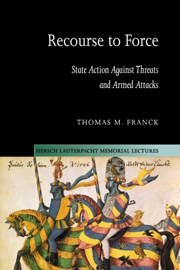Book contents
- Frontmatter
- Contents
- Acknowledgments
- 1 The United Nations' capacity for adapting to radical changes of circumstance
- 2 Use of force by the United Nations
- 3 The original parameters of self-defense
- 4 Self-defence against state-sponsored terrorists and infiltrators
- 5 Self-defense against ideological subversion
- 6 Self-defense against attacks on citizens abroad
- 7 Anticipatory self-defense
- 8 Countermeasures and self-help
- 9 The “purely humanitarian” intervention
- 10 What, eat the cabin boy? Uses of force that are illegal but justifiable
- Index
7 - Anticipatory self-defense
Published online by Cambridge University Press: 17 July 2009
- Frontmatter
- Contents
- Acknowledgments
- 1 The United Nations' capacity for adapting to radical changes of circumstance
- 2 Use of force by the United Nations
- 3 The original parameters of self-defense
- 4 Self-defence against state-sponsored terrorists and infiltrators
- 5 Self-defense against ideological subversion
- 6 Self-defense against attacks on citizens abroad
- 7 Anticipatory self-defense
- 8 Countermeasures and self-help
- 9 The “purely humanitarian” intervention
- 10 What, eat the cabin boy? Uses of force that are illegal but justifiable
- Index
Summary
The typology
Earlier chapters of this study have employed a typology for examining the UN system's response to states' “unauthorized” resort to force, i.e. in circumstances in which the state has not been the victim of a traditional armed attack and the Security Council has not voted to invoke collective measures under Charter Chapter VII. Chapter 3 has identified five clusters of justification advanced in support of such unauthorized recourse to force. Using this analytic typology, the study seeks to ascertain the extent to which each kind of unconventional justification has been validated in systemic practice.
From the foregoing examination of some of this practice, it appears that the principal organs of the United Nations have responded in accordance with the nuanced situational merits of each crisis, rather than in compliance with any general redefinition of the concept of “self-defence” contained in Article 51. Although the role of political horse-trading cannot be discounted, it appears that most countries have reacted with integrity, instance-by-instance, to the weight of factual and contextual evidence presented by advocates and critics of each use of force. This is also true in those instances in which the use of force has been justified as “anticipatory self-defence.”
Anticipatory use of force in self-defense as a legal concept
Anticipatory self-defense has a long history in customary international law. As early as 1837, it was canvassed by US Secretary of State Daniel Webster in the Caroline dispute.
- Type
- Chapter
- Information
- Recourse to ForceState Action against Threats and Armed Attacks, pp. 97 - 108Publisher: Cambridge University PressPrint publication year: 2002
- 3
- Cited by



